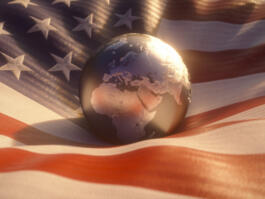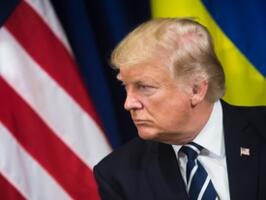Who's the Conservative Heretic?
A Commentary By Patrick J. Buchanan
In his coquettish refusal to accept the Donald, Paul Ryan says he cannot betray the conservative "principles" of the party of Abraham Lincoln, high among which is a devotion to free trade.
But when did free trade become dogma in the Party of Lincoln?
As early as 1832, young Abe declared, "My politics are short and sweet, like the old woman's dance. I am in favor of a national bank ... and a high protective tariff. These are my sentiments and political principles."
Campaigning in 1844, Lincoln declared, "Give us a protective tariff and we will have the greatest nation on earth."
Abe's openness to a protective tariff in 1860 enabled him to carry Pennsylvania and the nation. As I wrote in "The Great Betrayal: How American Sovereignty and Social Justice Are Being Sacrificed to the Gods of the Global Economy" in 1998:
"The Great Emancipator was the Great Protectionist."
During his presidency, Congress passed and Abe signed 10 tariff bills. Lincoln inaugurated the Republican Party tradition of economic nationalism.
Vermont's Justin Morrill, who shepherded GOP tariff bills through Congress from 1860 to 1898, declared, "I am for ruling America, for the benefit, first, of Americans, and for the 'rest of mankind' afterwards."
In 1890, Republicans enacted the McKinley Tariff that bore the name of that chairman of ways and means and future president.
"Open competition between high-paid American labor and poorly paid European labor," warned Cong. William McKinley, "will either drive out of existence American industry or lower American wages."
Too few Republicans of McKinley's mindset sat in Congress when NAFTA and MFN for China were being enacted.
In the 1895 "History of the Republican Party," the authors declare, "the Republican Party ... is the party of protection ... that carries the banner of protection proudly."
Under protectionist policies from 1865 to 1900, U.S. debt was cut by two-thirds. Customs duties provided 58 percent of revenue. Save for President Cleveland's 2 percent tax, which was declared unconstitutional, there was no income tax. Commodity prices fell 58 percent. Real wages, despite a doubling of the population, rose 53 percent. Growth in GDP averaged over 4 percent a year. Industrial production rose almost 5 percent a year.
The U.S. began the era with half of Britain's production, and ended it with twice Britain's production.
In McKinley's first term, the economy grew 7 percent a year. After his assassination, Vice President Theodore Roosevelt took over. His reaction to Ryan's free-trade ideology? In a word, disgust.
"Pernicious indulgence in the doctrine of free trade seems inevitably to produce fatty degeneration of the moral fibre," wrote the Rough Rider, "I thank God I am not a free trader."
When the GOP returned to power after President Wilson, they enacted the Fordney-McCumber Tariff of 1922. For the next five years, the economy grew 7 percent a year.
While the Smoot-Hawley Tariff, signed eight months after the Crash of '29, was blamed for the Depression, Nobel laureate Milton Friedman ferreted out the real perp, the Federal Reserve.
Every Republican platform from 1884 to 1944 professed the party's faith in protection. Free trade was introduced by the party of Woodrow Wilson and FDR.
Our modern free-trade era began with the Trade Expansion Act of 1962. Among the eight no votes in the Senate were Barry Goldwater and Prescott Bush.
Even in recent crises, Republican presidents have gone back to the economic nationalism of their Grand Old Party. With the Brits coming for our gold and Japanese imports piling up, President Nixon in 1971 closed the gold window and imposed a 10 percent tariff on Japanese goods.
Ronald Reagan slapped a 50 percent tariff on Japanese motorcycles being dumped here to kill Harley-Davidson, then put quotas on Japanese auto imports, and on steel and machine tools.
Reagan was a conservative of the heart. Though a free trader, he always put America first.
What, then, does history teach?
The economic nationalism and protectionism of Hamilton, Madison, Jackson, and Henry Clay, and the Party of Lincoln, McKinley, Teddy Roosevelt, and Coolidge, of all four presidents on Mount Rushmore, made America the greatest and most self-sufficient republic in history.
And the free-trade, one-worldism of Bush I, Clinton, Bush II and Obama enabled Communist China to shoulder us aside us and become the world's No. 1 manufacturing power.
Like Britain, after free-trade was adopted in the mid-19th century, when scribblers like David Ricardo, James Mill and John Stuart Mill, and evangelists like Richard Cobden dazzled political elites with their visions of the future, America has been in a long steady decline.
If we look more and more like the British Empire in its twilight years, it is because we were converted to the same free-trade faith that was dismissed as utopian folly by the men who made America.
Where in the history of great nations -- Britain before 1850, the USA, Bismarck's Germany, postwar Japan and China today -- has nationalism not been the determinant factor in economic policy?
Speaker Ryan should read more history and less Ayn Rand.
Patrick J. Buchanan is the author of the new book "The Greatest Comeback: How Richard Nixon Rose From Defeat to Create the New Majority." To find out more about Patrick Buchanan and read features by other Creators writers and cartoonists, visit the Creators website at www.creators.com.
COPYRIGHT 2016 CREATORS.COM
See Other Political Commentaries.
See Other Commentaries by Pat Buchanan.
Views expressed in this column are those of the author, not those of Rasmussen Reports. Comments about this content should be directed to the author or syndicate.
Rasmussen Reports is a media company specializing in the collection, publication and distribution of public opinion information.
We conduct public opinion polls on a variety of topics to inform our audience on events in the news and other topics of interest. To ensure editorial control and independence, we pay for the polls ourselves and generate revenue through the sale of subscriptions, sponsorships, and advertising. Nightly polling on politics, business and lifestyle topics provides the content to update the Rasmussen Reports web site many times each day. If it's in the news, it's in our polls. Additionally, the data drives a daily update newsletter and various media outlets across the country.
Some information, including the Rasmussen Reports daily Presidential Tracking Poll and commentaries are available for free to the general public. Subscriptions are available for $4.95 a month or 34.95 a year that provide subscribers with exclusive access to more than 20 stories per week on upcoming elections, consumer confidence, and issues that affect us all. For those who are really into the numbers, Platinum Members can review demographic crosstabs and a full history of our data.
To learn more about our methodology, click here.



